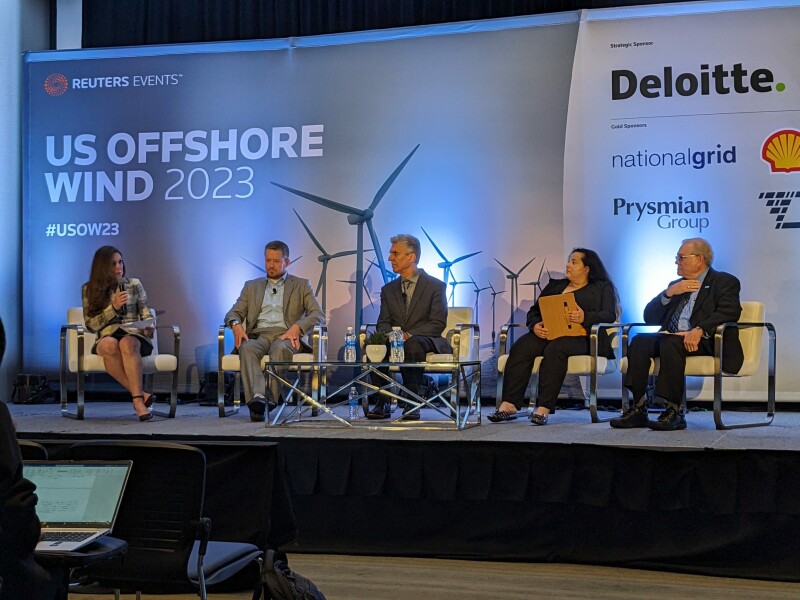Beating into headwinds but sailing on with support from U.S. federal and state policymakers, the offshore wind industry presented a snapshot of its current state at the US Offshore Wind 2023 conference held July 11-12 in Boston.
As the conference opened, wind advocates sounded upbeat tones. Jim Kendall, the director of the Bureau of Ocean Energy Management’s Gulf of Mexico regional office, said he wanted people to note how Shell was supporting the conference, which he said sends a huge message about energy industry support for wind.
According to Alicia Calero, regulatory compliance program manager at Avangrid Renewables, there are a lot of similarities between oil, gas, and offshore wind. The wind industry is building on things that worked and didn’t work – especially with the safety practices available for offshore wind.
Workforce development and building the U.S. supply chain are among the top concerns for the industry. After the conference's first-day sessions about finding people with experience working offshore, Kendall responded, “We already have people working offshore.”
Similarly, the Gulf of Mexico industrial base is already supplying wind industry needs. The first Jones Act-compliant turbine installation vessel, the 472’ Charybdis, is being built by Keppel AmFELS in Brownsville, Texas, for Dominion Energy’s Coastal Virginia Offshore Wind project. Early on, Gulf Island Fabrication, Houma, La., built the jacket foundations for the five-turbine Block Island Wind Farm project installed in 2016.
Five key areas were discussed at the two-day conference.
Workforce
Offshore wind workforce assessments have found the industry needs to employ an average of 15,000 to 18,000 full-time workers every year between 2024 and 2030. To meet U.S. goals, states need a well-coordinated regional workforce development strategy. This includes creating job opportunities within communities impacted by offshore wind energy development and, contacting colleges technical schools to teach the trades, and work with labor unions to bring in younger members.
There are a lot of U.S. offshore workers – however, they prefer to work out of Louisiana or Texas. The oil market has 50,000 employees looking for new work. Developers cannot use resources from overseas because of costs.
Of note: 21% of the global wind energy workforce are women. Some 8% hold senior management roles.
In Massachusetts, energy planners are releasing their 2030 workforce needs assessment shortly. They estimate they need about 35,000 to 40,000 more people working in clean energy. Other states up and down the East Coast have just as ambitious goals.
Collaboration
Christopher Fordham, a senior manager with McDermott International Engineering said his group is taking all the knowledge they’ve learned and continuing to learn and apply that to the U.S. Northeast. It is a continuous learning curve, he said, and no longer a single mindset of “we’re working on it”.
Massachusetts focuses on partners in the industry. These include stakeholders to reduce risk, increase market confidence, and advance economic and workforce opportunities. Figures show they need around 23 gigawatts by 2050. That’s according to their clean energy and climate plan. That translates to about one gigawatt per year over the next 25 years. This means projects deployed with taken from existing fixed areas in Southern New England, Maine and additional lease areas south beyond the Mid-Atlantic states.
Collaboration also includes supporting fishermen, jobs associated with the public, supply chain components, and each other. Buy-in is necessary for the long term. Not all stakeholders have the capacity to be engaged, and everyone involved needs to be transparent with others.
Supply Chain
Building a domestic supply chain will be critical for the sustainable growth of the offshore wind industry. The biggest barriers are cost overruns, finding vendors who include safety, and local suppliers that understand their marketplace. It takes patience and local vendors' understanding of how complex the U.S. offshore wind industry is.
In the U.S., however, there is widespread uncertainty about the level of investment necessary to build critical resources. Plus, the significant gaps in manufacturing ports, vessels, work, and workforce in order to meet our targets.
Patrick Henry, senior director of the sustainable business group at DAI, said a lot of operators coming into an offshore wind space traditionally work in other industries. Globally, they're very good at supplier development programs. It’s what they've had to do to operate in a greenfield environment.
The federal Inflation Reduction Act (IRA) tool doesn’t benefit projects prior to 2023. It does, however, allow for some tax credits, incentives for clean energy, and manufacturing in the US.
Permitting
Michael Brown, country manager of U.S., Ocean Winds, said developers are struggling with permits at both the state and federal level.
“We need to see the state's composition,” said Brown. “Or we need to see the federal government and the interagency issues that we're all suffering at so that we can get our elements for our projects.”
There are several challenges. These usually entail counting operations lost while working on these issues, but no one is making progress. They’re facing interagency issues and other challenges. Yet, they can find technological or mechanization solutions.
Pricing
Equinor US Wind president Molly Morris said to look at pricing as the perfect storm of what's happening right now. She feels lucky in some ways to have contracts that are negotiable with the industry, and fairway, and knows that they have a place where they’ve been able to sell their energy.
However, the downside is a locked project price that is no longer viable. These price challenges are due to high inflation, supply chain challenges, and squeezing manufacturers to make factory buildings bigger, to name a few. Plus, she said, developers are bidding on technology that doesn’t exist yet.



